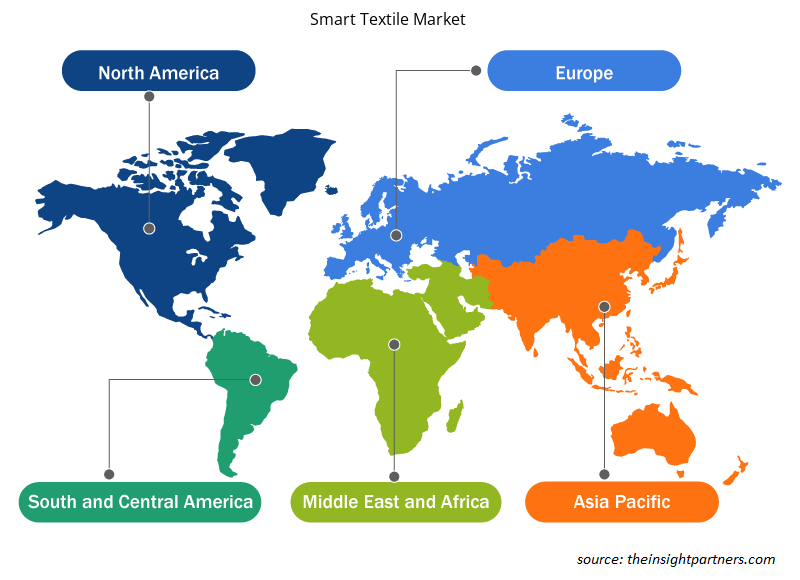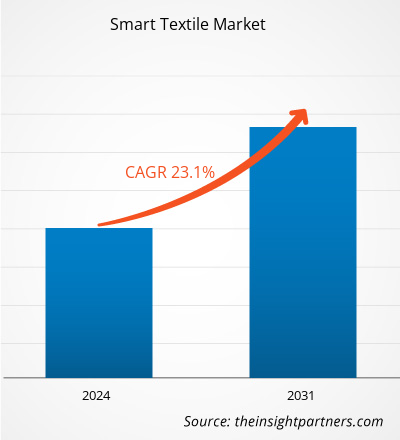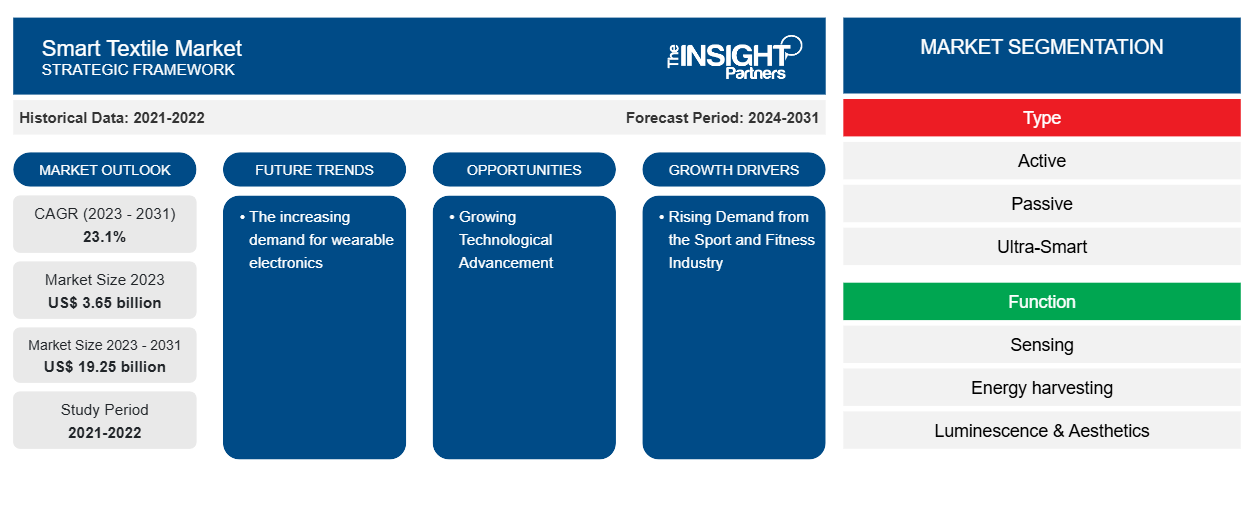La taille du marché des textiles intelligents devrait atteindre 19,25 milliards USD d'ici 2031, contre 3,65 milliards USD en 2023. Le marché devrait enregistrer un TCAC de 23,1 % en 2023-2031. La demande croissante d'électronique portable devrait rester une tendance clé du marché des textiles intelligents.
Analyse du marché des textiles intelligents
Le secteur textile a connu une transformation considérable grâce aux progrès réalisés dans le domaine des matériaux textiles intelligents, qui ont permis aux entreprises d'étendre leur portée à des applications et des domaines de haute technologie en dehors de leur marché traditionnel. Les textiles intelligents sont des matériaux dotés d'une puissance de calcul intégrée pour offrir des fonctionnalités supplémentaires telles que la stimulation, la communication et la surveillance. L'industrie de l'électronique portable est en pleine expansion en raison de la tendance à la réduction des tailles dans l'électronique moderne et de la demande croissante de gadgets intelligents. Le développement de la RFID , des technologies de capteurs et de la nanotechnologie dans les textiles a également stimulé l'expansion du marché.
Aperçu du marché des textiles intelligents
Les textiles intelligents sont des textiles qui ont été combinés avec des éléments numériques tels que des fibres conductrices, des microcontrôleurs et des capteurs. Ces textiles ont la capacité de percevoir, de réagir et de s'adapter aux changements de leur environnement ou aux stimuli provenant de causes chimiques, mécaniques ou thermiques. Les textiles intelligents, contrairement aux matériaux classiques, incluent des fonctionnalités interactives qui peuvent transférer des données. Ils sont de plus en plus utilisés dans les secteurs de la santé, du sport, de la mode et de l'armée. Dans le domaine de la santé, ils peuvent surveiller les signes vitaux et avertir le personnel médical. Ils sont capables de suivre les paramètres de performance dans le sport. Les utilisations militaires comprennent le camouflage amélioré et les gilets pare-balles avec des dispositifs de communication intégrés.
Personnalisez ce rapport en fonction de vos besoins
Vous bénéficierez d'une personnalisation gratuite de n'importe quel rapport, y compris de certaines parties de ce rapport, d'une analyse au niveau des pays, d'un pack de données Excel, ainsi que de superbes offres et réductions pour les start-ups et les universités.
- Obtenez les principales tendances clés du marché de ce rapport.Cet échantillon GRATUIT comprendra une analyse de données, allant des tendances du marché aux estimations et prévisions.
Moteurs et opportunités du marché du textile intelligent
Demande croissante de l'industrie du sport et du fitness
Les amateurs de fitness et les athlètes sont constamment à la recherche de méthodes pour améliorer les résultats et les performances de leurs entraînements. Les textiles intelligents sont parfaitement adaptés à ce parcours d’optimisation. Ces textiles, qui vont des chaussettes qui évaluent la démarche aux t-shirts qui suivent l’activité musculaire, offrent une multitude de données qui peuvent être utilisées pour modifier les plans d’entraînement et éviter les accidents. De plus, les données collectées peuvent être synchronisées avec des smartphones ou d’autres appareils, permettant une action instantanée en réponse à des commentaires en temps réel. Les athlètes et les coureurs occasionnels peuvent désormais accéder à ce degré de collecte de données très précises qui était auparavant réservé aux laboratoires sportifs spécialisés. En outre, l’attention croissante portée aux tendances mondiales en matière de santé et de bien-être stimule la demande de textiles intelligents dans le sport et le fitness, car ils offrent un moyen simple de surveiller de nombreuses données qui peuvent contribuer à un mode de vie meilleur et plus actif.
Progrès technologiques croissants
L'industrie textile a changé en raison de l'introduction de nouvelles technologies telles que l'intelligence artificielle (IA) et l'Internet des objets (IoT). L'IA, le Bluetooth Low Energy (BLE), l'informatique de pointe et les données cloud sont tous combinés dans de nouveaux vêtements intelligents en cours de production. Ces vêtements peuvent surveiller et transmettre les données du porteur, telles que la température, la fréquence cardiaque, la tension artérielle et la transpiration. L'IA a la capacité de récupérer et de collecter des données opérationnelles à la fois dans le passé et le présent, ainsi que d'offrir des informations qui peuvent améliorer la productivité du porteur. L'IA est fréquemment utilisée dans la fabrication textile à diverses fins, notamment la correspondance des couleurs, l'inspection des motifs et la détection des défauts. En outre, l'intégration de l'IA a permis de produire des vêtements intelligents qui utilisent des capteurs électriques et IoT pour offrir une expérience utilisateur exceptionnelle. Ainsi, l'intégration de technologies dans les textiles peut créer une expérience plus confortable et plus axée sur la santé, ce qui devrait créer une opportunité de croissance pour le marché des textiles intelligents au cours de la période prévue.
Analyse de segmentation du rapport sur le marché des textiles intelligents
Les segments clés qui ont contribué à l’élaboration de l’analyse du marché des textiles intelligents sont le type, la fonction et le secteur vertical.
- En fonction du type, le marché des textiles intelligents est segmenté en actifs, passifs et ultra-intelligents. Le segment actif devrait croître au cours de la période prévue.
- Par fonction, le marché est segmenté en détection, récupération d'énergie, luminescence et esthétique et thermoélectricité. Le segment de la détection devrait croître au cours de la période prévue.
- Par secteur d'activité, le marché est segmenté en soins de santé, sports et fitness, mode, militaire et automobile. Le segment sports et fitness devrait croître au cours de la période prévue.
Analyse des parts de marché du textile intelligent par zone géographique
La portée géographique du rapport sur le marché des textiles intelligents est principalement divisée en cinq régions : Amérique du Nord, Asie-Pacifique, Europe, Moyen-Orient et Afrique, et Amérique du Sud/Amérique du Sud et centrale.
En termes de chiffre d'affaires, l'Amérique du Nord représente la plus grande part de marché du textile intelligent. Le marché de cette région est segmenté entre les États-Unis, le Canada et le Mexique. L'expansion du marché régional est stimulée par l'augmentation des investissements publics dans les industries de la défense et de l'armée ainsi que par un fort pouvoir d'achat. En outre, une grande partie de la population de la région souffre d'obésité, ce qui en fait l'un des principaux problèmes de santé. En conséquence, les consommateurs gravitent vers un mode de vie sain et achètent des produits qui favoriseront leur activité physique continue. Par conséquent, afin de rester compétitifs, les acteurs du marché concentrent leurs efforts sur la fourniture d'articles de pointe à des coûts abordables. En outre, l'augmentation des dépenses publiques en matière de recherche et développement, en particulier dans le secteur de la santé, alimente davantage la croissance du marché du textile intelligent.
Aperçu régional du marché des textiles intelligents
Les tendances régionales et les facteurs influençant le marché du textile intelligent tout au long de la période de prévision ont été expliqués en détail par les analystes d’Insight Partners. Cette section traite également des segments et de la géographie du marché du textile intelligent en Amérique du Nord, en Europe, en Asie-Pacifique, au Moyen-Orient et en Afrique, ainsi qu’en Amérique du Sud et en Amérique centrale.

- Obtenez les données régionales spécifiques au marché du textile intelligent
Portée du rapport sur le marché des textiles intelligents
| Attribut de rapport | Détails |
|---|---|
| Taille du marché en 2023 | 3,65 milliards de dollars américains |
| Taille du marché d'ici 2031 | 19,25 milliards de dollars américains |
| Taux de croissance annuel composé mondial (2023-2031) | 23,1% |
| Données historiques | 2021-2022 |
| Période de prévision | 2024-2031 |
| Segments couverts | Par type
|
| Régions et pays couverts | Amérique du Nord
|
| Leaders du marché et profils d'entreprises clés |
|
Densité des acteurs du marché : comprendre son impact sur la dynamique des entreprises
Le marché des textiles intelligents connaît une croissance rapide, tirée par la demande croissante des utilisateurs finaux en raison de facteurs tels que l'évolution des préférences des consommateurs, les avancées technologiques et une plus grande sensibilisation aux avantages du produit. À mesure que la demande augmente, les entreprises élargissent leurs offres, innovent pour répondre aux besoins des consommateurs et capitalisent sur les tendances émergentes, ce qui alimente davantage la croissance du marché.
La densité des acteurs du marché fait référence à la répartition des entreprises ou des sociétés opérant sur un marché ou un secteur particulier. Elle indique le nombre de concurrents (acteurs du marché) présents sur un marché donné par rapport à sa taille ou à sa valeur marchande totale.
Les principales entreprises opérant sur le marché du textile intelligent sont :
- Dupont
- Jabil
- Sensoria
- Vêtements interactifs AG
- Adidas
- Hexoskin
Avis de non-responsabilité : les sociétés répertoriées ci-dessus ne sont pas classées dans un ordre particulier.

- Obtenez un aperçu des principaux acteurs du marché du textile intelligent
Actualités et développements récents du marché du textile intelligent
Le marché des textiles intelligents est évalué en collectant des données qualitatives et quantitatives issues de recherches primaires et secondaires, qui comprennent d'importantes publications d'entreprise, des données d'associations et des bases de données. Voici une liste des évolutions du marché :
- Loomia Technologies s'est associée à Advanced Functional Fabrics of America (AFFOA) pour développer des gants chauffants hautement tactiles qui pourraient être applicables aux clients commerciaux/récréatifs et militaires. Pour ce projet collaboratif, Loomia fournira la technologie à utiliser dans un insert de gant chauffant, tandis qu'AFFOA dirigera la découverte client, fournira des conceptions d'architecture système et produira une unité de contrôle d'interface. En plus de l'insert de gant chauffant, Loomia développera également une manche chauffante. Les deux articles offriront un confort thermique aux utilisateurs dans les climats difficiles ou dans d'autres zones où cette protection est jugée nécessaire. (Source : Loomia Technologies, communiqué de presse, 2022)
- L'association britannique de la mode et du textile (UKFT) a annoncé un partenariat avec la Smart Textile Alliance. Le partenariat entre la STA et l'UKFT sera mutuellement bénéfique, ouvrant le potentiel de nouvelles voies d'innovation dans la technologie et la mode. (Source : UKFT, communiqué de presse, 2021)
Rapport sur le marché des textiles intelligents : couverture et livrables
Le rapport « Smart Textile Market Size and Forecast (2021-2031) » fournit une analyse détaillée du marché couvrant les domaines ci-dessous :
- Taille du marché et prévisions aux niveaux mondial, régional et national pour tous les segments de marché clés couverts par le périmètre
- Dynamique du marché, comme les facteurs moteurs, les contraintes et les opportunités clés
- Principales tendances futures
- Analyse détaillée des cinq forces de PEST/Porter et SWOT
- Analyse du marché mondial et régional couvrant les principales tendances du marché, les principaux acteurs, les réglementations et les développements récents du marché
- Analyse du paysage industriel et de la concurrence couvrant la concentration du marché, l'analyse de la carte thermique, les principaux acteurs et les développements récents
- Profils d'entreprise détaillés
- Analyse historique (2 ans), année de base, prévision (7 ans) avec TCAC
- Analyse PEST et SWOT
- Taille du marché Valeur / Volume - Mondial, Régional, Pays
- Industrie et paysage concurrentiel
- Ensemble de données Excel
Rapports récents
Témoignages
Raison d'acheter
- Prise de décision éclairée
- Compréhension de la dynamique du marché
- Analyse concurrentielle
- Connaissances clients
- Prévisions de marché
- Atténuation des risques
- Planification stratégique
- Justification des investissements
- Identification des marchés émergents
- Amélioration des stratégies marketing
- Amélioration de l'efficacité opérationnelle
- Alignement sur les tendances réglementaires





















 Obtenez un échantillon gratuit pour - Marché du textile intelligent
Obtenez un échantillon gratuit pour - Marché du textile intelligent